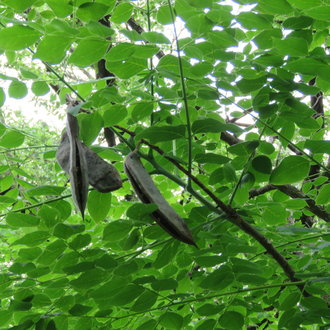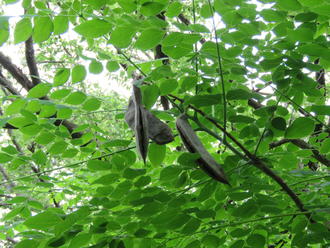Kentucky Coffeetree (Gymnocladus dioicus (L.) K. Koch)
Also classified as Gymnocladus dioica (Alternate Ending).
↑Summary
A large tree native to the central to northeastern U.S.
↑Range - Expand
| Legend | Color |
| Native | |
| Native or Expanded or Not Present | |
| Expanded or Not Present | |
| Expanded | |
| Native or Not Present | |
| Native or Expanded |
This tentative map is based on our own research. It may have limited data on Canada and/or Mexico, and there is some subjectivity in our assignment of plants as introduced vs. expanded. Read more in this blog post.
Although this plant occurs somewhere in each of these regions, it may only occur in a small part of some or all of them.
This species is widely used in landscaping well outside its native range, and has established in the wild at a number of different locations. We mark these new locations as expanded because they are near its native range. We mark a greater portion of its range as non-native than BONAP does, reflecting the treatment in FSUS. It is also noteworthy that this species, like the osage-orange (Maclura pomifera), may have had a broader range prior to the extinction of the North American megafauna. This species is also native to part of Canada and now occurring in areas beyond its native range there too; we have yet to build the portion of its map in Canada.
↑Habitat
Found in moist soils in bottomlands, and moister sites in open, rocky woodlands. More common on limestone soils and areas that have been glaciated, but uncommon throughout much of its range. Tolerates both drought and occasional flooding, alkaline soils, and compacted soils.
Requires high-light conditions for establishment, and only persists in the earlier-successional stages of closed-canopy forests. It can persist longer on more open sites.
↑Life Cycle
Seedpods are large and heavy; most fall close to the tree, although pods falling into water can be carried long distances by water. Some seedpods are retained on the tree in winter, where they may fall on crusted snow and be moved a small distance by wind.
The seedpods are slow to decay and may even remain intact for longer than a year. Seeds exhibit a long dormancy, and may seed bank for a number of years.
↑Uses
This tree is widely planted, including far outside its native range, where it is valued for its ease of growing and tolerance of a wide range of conditions, including urban conditions.
The seeds have been roasted and used as a coffee substitute, hence the name; it does not contain any caffeine.
The wood has a number of desirable properties, including some decay resistance and good workability, but its availability is limited, and as such it tends to be relatively expensive. Like many other legumes, the wood is highly fluorescent under a blacklight.
↑Related Plants
This plant is the only member of its genus in North America; two other species occur in east Asia.
The broader Umtiza clade of the Caesalpinioideae subfamily of the bean (Fabaceae) family also contains the two native species honeylocust (Gleditsia triacanthos) and water locust (Gleditsia aquatica), both of which overlap with this species in range, as well as carob tree (Ceratonia siliqua), which has been introduced to southern California and Arizona and does not overlap in range.
↑Notes
Although most legumes have the ability to fix nitrogen, extracting it from the atmosphere and converting it into a form usable by plants, this tree comes from a lineage that has lost this ability.
↑Links & External Resources
• Coffeetree | The Wood Database (About This Site)
• Gymnocladus dioicus (Kentucky Coffee Tree) | Illinois Wildflowers (About This Site)
• Gymnocladus dioicus (Kentucky Coffeetree) | USDA PLANTS Database (About This Site)
• Gymnocladus dioicus | Go Botany (About This Site)
• Kentucky Coffeetree | Virginia Tech Dendrology Factsheets (About This Site)
• Gymnocladus dioicus | Biota of North America Project (BONAP) (About This Site)
• Gymnocladus dioicus | NatureServe Explorer (About This Site)
• Kentucky coffee tree | Missouri Botanical Garden Plant Finder (About This Site)
• Gymnocladus dioicus | Missouri Plants (About This Site)
• Kentucky Coffeetree | Maryland Biodiversity Project (About This Site)
• Gymnocladus dioica (L.) K. Koch (Kentucky Coffee-tree) | Digital Atlas of the Virginia Flora (About This Site)
• Gymnocladus dioicus (L.) K.Koch | Plants of the World Online (POWO) (About This Site)




